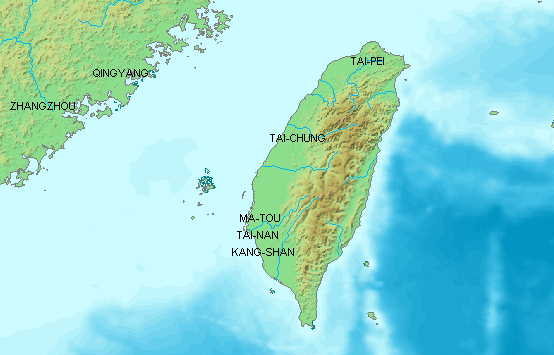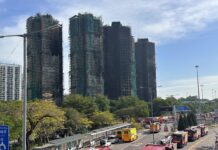Taiwan was first incorporated into China by the Qing dynasty (1644-1911) in 1683. It first became a province of China in 1885, ten years before the Qing surrendered it to the Japanese in the Sino-Japanese war.
By Laurence CoatesHan Chinese settlers began arriving around a thousand years ago. The original inhabitants, only around 2% of the population today, are of Malayo-Polynesian ancestry. The island has historically been a refuge for groups persecuted on the mainland. Imperial China generally viewed Taiwan with scorn as ’barbarian territory’, ’a haven for pirates and rebels’ and had little interest in it. Only after the brief period of Dutch colonisation (1624-62) did the Chinese elite show an interest, for reasons of national defence against other powers. At different times the US, Britain, France, Japan and Prussia all showed an interest in seizing Taiwan.
A history of rebellion
The Qing emperors were ethnic Manchu, not Han, and their rule was a brutal one throughout China. Millions of Han, Muslims and other groups were massacred in military campaigns and crackdowns. Their subjugation of Taiwan produced similar results: 159 ”sizeable rebellions” during the two and a half centuries of Qing rule. According to Denny Roy (Taiwan a Political History, Cornell University Press 2003): ”Mainlanders commonly said of Taiwan, ’Every three years an uprising, every five years a rebellion.’”
The Japanese occupation (1895-1945), while industrialising the island, encountered sustained resistance particularly from the aborigines living in the mountain areas, and the Hakka.
When the KMT took control from the Japanese in 1945, they treated the island more as colonial plunder than liberated territory. KMT corruption, brutality and racism towards the Taiwanese, provoked a huge uprising in February 1947, at the height of the civil war on the Chinese mainland. The ”2-2-8 incident” as it is known, triggered a mass popular movement, which seized control of nine cities and presented ”Thirty Two Demands” including democratic rights (freedom of speech, press, assembly, the right to strike, equal rights for aborigines) and genuine autonomy (majority of government posts to Taiwanese as opposed to mainlanders, Taiwanese control of the police force, greater Taiwanese control over industries confiscated from the Japanese). When reinforcements arrived, Chiang Kai-shek ordered the his military commanders to ”Kill them all; keep it secret.” The notoriously undisciplined KMT troops went on a rampage of shooting, bayoneting, raping and robbery that, according to some claims, resulted in 20,000 dead. Opponents of Taiwanese independence generally dismiss the ”2-2-8 incident” as the work of ”right-wingers and pro-Japanese agents”. But this was not the attitude of Mao Zedong, for example, who pointed to Communist involvement in the movement. The small Taiwanese Communist Party was fully involved in this pro-autonomy, anti-KMT movement, and faced stiff repression in the aftermath as Chiang Kai-shek consolidated his military dictatorship on the island.
An explosive mix
There are several distinct ethnic groups and languages in Taiwan while the official language is Mandarin. Apart from the aborigines who are an extremely oppressed and marginalised minority (poverty, alcoholism, educational disadvantage) the main ethnic groups in Taiwan, are as follows:
The Fujianese or ’Minnan’ (meaning south of the Min river in China’s Fujian province) who make up around 70% of the population. They began arriving about a thousand years ago, but especially after the fall of the Ming dynasty in 1644. They speak a dialect of Hokkienese (also known as ’Taiwanese’).
The Hakka, sometimes compared to the Roma people of Europe because of their distinct culture and strong clan affiliation, are of northern Chinese origin but fled southwards to escape persecution 1500 years ago. They were the first Han Chinese settlers in Taiwan, around a thousand years ago, although the main wave of Hakka migration came after the defeat of the Taiping Rebellion (1851-64), which was led by Hakka. The Taiping, a precursor to Mao’s guerrilla armies (demanding agrarian reform, sexual equality and a rejection of Confucian values), came close to toppling the Qing dynasty. Up to 30 million were massacred and whole provinces in southern China laid to waste in order to defeat the rebellion. Around 15% of Taiwan’s population are Hakka. Hakka is one of the seven or eight main Chinese dialects.
The above groups are broadly referred to today as ’native Taiwanese’, in contradistinction to the ’mainlanders’ – around 10% of the population – who trace their arrival to the period after the Japanese defeat in 1945. Within the mainlander population, mostly originating from south or central China, are a multitude of dialects.’
Divide-and-rule’
The KMT dictatorship was brutal and discriminatory, employing classical ’divide-and-rule’ methods. Traditional rivalries between Hakka, Fujianese and aborigines were reinforced. With the Fujianese more strongly established on the land, landless Hakka were recruited into the police force and the state sector, causing resentment from Fujianese. Mainlanders dominated the highest government posts, the economy and to this day control the army. The Fujianese dialect was banned in schools and public broadcasting up until the last decade or so. Advocating independence was, like Communism, a capital offence. Mainlanders are concentrated in the cities, comprising the majority ethnic group in the capital, Taipei. Fujianese predominate in the rural areas and especially in the south of the island, which is now a stronghold for the formally pro-independence (in practise ’ex-pro-independence’) DPP.
The semi-racist and reactionary arguments of some pro-independence politicians – against ‘Chinese’ and against ‘Communism’ – repel many, including of course many youth, who therefore reject independence as ’reactionary’. The pro-Taiwan camp’s reliance on support from US and Japanese imperialism produces a similar effect. On the other side, the outlook of many Taiwanese who support the pro-independence camp is shaped by a deep sense of historical injustice, misrule and oppression at the hands of mainland political elites: from four decades of KMT dictatorship to the nationalist militarism of the CCP today. In the universities – always a key barometer – the mood is overwhelmingly Taiwan nationalist, if not explicitly pro-independence.




